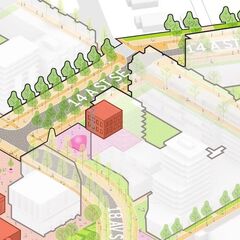Inglewood has seen a pretty good amount of development in the past decade, on par with the amount of buildings of significance Marda Loop and Kensington have seen I think.
Atlantic Avenue Art Block in 2012,
Southbank in 2020,
Avli in 2020,
Torode's first one in 2016,
Torode's second in 2020,
Sarina's ID project in 2017,
and YWCA in 2019 and
SoBow in 2015.
Under construction we have Konect, and the big proposals already mentioned above plus The Grid, which I think has gone stale. Not to mention the build out of Matco's remaing SoBow lands. Just shows how much time and effort is needed to move the needle on densifying Calgary.
True - the pipeline of development is long and big projects take time. Hopefully some of these more material projects start being realized.
It's not for lack of proposals that there has been little residential development. I am surprised that Inglewood grew by only 300 people in 5 years. I can think of at least 4 new multi-family projects added in that time span. A 5th one is under construction by Cairo Developments
On top of that there have been at least 4 proposals .... RNDSQR, Landstar and two by Hungerford that have languished. Another one by Torode was up for sale.
Also keep in mind when thinking about longer-term (30 - 50 years) density/population trends is the collapse in family size being a huge factor. I probably could look it up somewhere, but Inglewood in 1968 was likely in the 3 or 4 people/unit, where it's closer to 1.8 people / unit today. That's a huge decline in local population simply because people are having smaller families.
There's a few factors at play here, but the decline in family size post-1960 is a main reason for the lower population compared to the past. However, the lack of significant redevelopment to increase the housing supply/diversity is a main reason for why Inglewood stays low for longer than other areas.
This single project would change all that if it comes to fruition
1,300 units are proposed, that works out to ~2,000 - 2,500 people assuming something close to 2021 Inglewood people/units. Because the neighbourhood is so small to begin with, this development will materially increase the supply of every unit type in Inglewood substantially (+52% unit growth, +40-60% population growth over the Inglewood 2021 totals). The added housing diversity will help stabilize and insolate the community against future demographic changes as more housing diversity that will be available for whatever family size/type/lifestyle trends emerge.
The scale of the development will also create phases, so units will be built over many years with different price-points, amenities and definitions of "modern" living design. This helps create a continuum of prices and promotes long-run affordability options in the area. What was once a modern kitchen, but has since become outdated is a subtle way to accidentally make some units in popular areas $100K cheaper than others.
In many ways Inglewood is the same story as all Calgary's inner city neighbourhoods. They were designed as nuclear family mono-cultures, optimized for a world of two parent and 2+ kids per unit. That is no longer is how the average or even majority of families work, so areas that haven't adapted their housing stock to the new trends sees major population declines. Combine with long-term house price growth, almost every popular neighbourhood is at risk of emptying out and calcifying to high-income single-family only if we fail to add housing diversity.
Uniquely important for Inglewood - retail trends also shift. Popular neighbourhood retail districts that are ultra-dependent on visitors from outside the community have it in there best interest to strengthen/diversify their local ecosystem with more people and diversity nearby. Creates a small but important captive consumer market and keeps the lights on during the quieter days of the week or when a weekend snowstorm stops tourists from journeying from the burbs to the area.
A great local case study on this is the Beltline. The Beltline's retail scene highly benefits from outside visitors - but many businesses are profitable on the quieter days of the week simply because there's so much local traffic all the time now. Other destination retail areas need to lean into being pro-density and residential growth so they don't go extinct when trends or events shift the destination consumer elsewhere.







